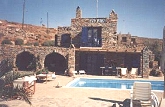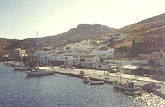| KEA -- HISTORY Because of its proximity to Attica, the history of Kea is closely linked to that of Athens, and the island has been inhabited since the late Neolithic period. During the Persian invasion the Keans fought alongside the Athenians at both the battles of Salamis and Artemisium. The only Cyclades islands to fight on the side of the Greeks apart from Naxos were Kea, Kythnos and Tinos. The Parians prudently waited at Kythnos to come in on the winning side, and for this act of duplicity they were afterwards forced to pay a heavy indemnity by Athens. After a final victory against the Persians in 479 BC the 31 states that had fought together at Plataea dedicated a trophy to Apollo which was placed in the sanctuary at Delphi. When, in 1912 the column was discovered by archeologists in Constantinople and cleaned of the debris, the names of the 31 victorious states were found inscribed on the lower coils of the bronze serpents. Amongst the proud names of the Cyclades islands was Kea. During the War of Independence, just as in ancient times, Kea was the first in archipelago to join the Greek alliance, a position for which the islanders of today are extremely proud. The island is oval shaped with the main axis extending approximately 20 km from the south-west to the north-east with a maximum girth of about 10 km. The population is approximately 1500. Kea is an enticing island. Its rocky and forbidding perimeter is enlivened inland by old oak trees and almond groves, small hospitable villages and beautiful empty beaches. The ferry boat arrives at Koressia, a pleasant port, but with the uneven expansion of the town it has little beauty to lose. Voulkari, a couple kms to the north is picturesque, with the important archaeological site of Agia Irene. Deposits of Cycladic, Minoan and Mycenaean pottery have been found on this site and are helping to establish chronological relationships between these periods. Further along the road, some 5 kms away, is Otzias yet another popular beach which is exposed to the prevailing wind. More interesting, some 5 kms further eastward, is the 18th century monastery of Panayia Kastriani with some spectacular views towards other islands in the Cyclades. From here you can reach the capital of the island, Ioulia or Chora. Chora, with its numerous red-tiled roofs cascading down the side of the hill, is by no means a typical Cycladic village, but it is stunningly situated in an arch-shaped fold in the hills. The lower reaches across the spur to the Kastro, a half demolished Venetian fortress incorporating stones from an ancient temple to Apollo. Fifteen minutes northeast of the town is the Lion of Kea a 6th century BC sculpture carved out of living rock. 6 m long and 3 m high, it is an imposing beast, and it is truly striking seen from a distance. Southwest from the town the crumbling Hellenisitc watchtower of Agia Marina sprouts dramatically from the grounds of a 19th century monastery. Beyond, sprawls the lovely agricultural valley of Pisses ending in a wide and underdeveloped beach. Back in Chora is a road that leads to the hamlet of Ellinika and Kato Meria and then on to Poles where one can find the ruins of Karthaia tucked away on the opposite south eastern edge of the island at Polis Bay The Cyclades have a magic all of their own, the remote beaches, the scented hills and the cool olive groves still beckon and restore one's soul through the serenity of the island scene. Whether you love the chatting and laughing in the island's taverns and coffee shops or listening to the haunting, lovely "nisiotika tragoudia" and watching the islanders dance through the intricate movements of a sirtaki or ballo, you realize that these islands have a special attraction and will draw you back into a timeless life again and again. Kea is one of these islands.
Back to Cyclades Islands Copyright: Hellenic Electronic Center |


|
|